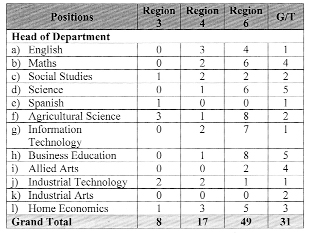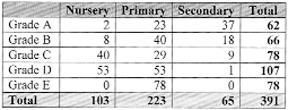Dear Editor,
Sunday’s January 29 publication of the Vacancy Notice 2012 by the Teaching Service Commission makes interesting reading. But before examining the numbers, it may be useful to highlight some of the conditionalities included in the finer print, while noting in general the length of instructions to applicants.
En passant one must wonder which profession in or out of the public service is required to comply with comparable procedures; suffer specified ineligibilities; and satisfy such unimaginatively rigid criteria as obtain in the Guyana Teaching Service. Although advised of the rationale for the differentiation, it would appear that accumulated experience would have been utilised, first of all, to facilitate an evaluation of comparative strengths and weaknesses with a view to putting the management of schools generally on a more equal footing.
That only teachers in the system can offer their candidature provides pause for debate. The restriction excludes former teachers who may have transitioned to other employment, or indeed merely to private schools, from displaying an interest to re-enter the public teaching system. (They may well be responding to the lure of vacancies in Regions 1, 2, 7 and 9!)
Meanwhile, teachers in situ are expected to take the following seriously:
“6. Please note, teachers are limited to apply for a maximum of four (4) advertised vacancies. Any additional application will be discarded.”
“7. Teachers should apply only for those advertised vacant posts which they intend to take up, if offered, and in which they intend to remain for at least two (2) years unless they are transferred to a similar post or they are promoted to another post in a school.”
“8. Teachers who fail to take up the offer of an appointment within one (1) month of the date of the letter offering them the appointment may be debarred from promotion for up to three (3) years. Teachers are free, however, to withdraw any application made for a post, provided that the notification of withdrawal reaches the Secretary, Teaching Service Commission . . . no later than the Closing Date… which is noon of Friday, March 09, 2012.”
Apart from the incidental fact that the transmission process could be disrupted by some logistical default, it is difficult to accept this conditionality would not be applied on a case by case basis.
While one appreciates the obvious need for stability within individual teaching teams, is there not the implication that the TSC only reserves the right to effect movement at any time deemed necessary? Why should this be a non-negotiable in light of the prevailing human resource constraints? Not totally irrelevant of this exercise, must be the recently published pronouncement by the Education Minister on the shortage of Maths and Science teachers. Actually the Vacancy Notice in question reveals a much wider dimension of shortages which, by implication, do not seem to have merited similar priority attention from the ministry. For example, the following is a table on heads of department (HOD), which reflects only the comparatively more significant incidence of (specialist) shortages in the indicated subject areas:
Vacancies for HODs also occur in the other regions not included above, of which excluding Region 9, the five show a total of 30 vacancies for HODs.
As a matter of some interest the total number of senior posts for which applications have been invited are distributed in the following categories of schools:
TABLE
Categories of School
Note: Excludes practical instruction centres
Based on the numbers above it would appear, from an outsider’s standpoint, that institutions demanding focused attention would include a) Nursery – Grades C and D; b) Primary – Grades B, D and E; c) Secondary – Grade A.
However, the relevant authorities must know better, and be able to identify the more substantive fault lines. Certainly the approach to the problem would require more than motivational speeches. Arguably there is a case for reviewing the pertinent data of the past decade (at least), which would reflect teaching capacity, departure/retention rates (as they affect identified regions and grades of schools), while taking into account issues of morale, in addition to pay. The review should involve not only the principal education actors, but also their private sector counterparts, parent-teacher associations, employers, and other identified stakeholders. The exercise must result in the articulation of a recruitment, development/retention plan, which amongst other objectives, must aim to achieve the needed supply of relevant skills to an expanding, more complex and competitive skills market.
In the meantime the table below merely summarises the spread of vacancies as advertised by the TSC for relevant senior positions.
TABLE
Vacancies by Region
Yours faithfully,
E B John




